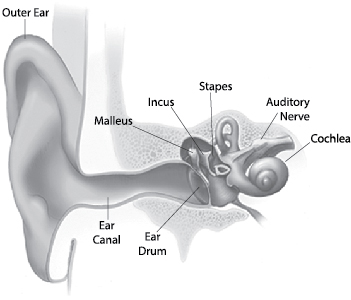Sound Waves and Music
craig kelleher
Sound is produced when something vibrates. This vibrating body causes the objects around it, water, air, and other things to vibrate. Vibrations in air are called traveling longitudinal waves, which we can hear. Sound waves consist of areas of high and low pressure called compressions and rarefactions, respectively. Shown in the diagram below is a traveling wave. The shaded bar above it represents the varying pressure of the wave.
Lighter areas are low pressure, rarefactions, and darker areas are high pressure, compressions. One wavelength of the wave is highlighted in red. This pattern repeats indefinitely. The wavelength of voice is about one meter long. The wavelength and the speed of the wave determine the pitch, or frequency of the sound. Wavelength, frequency, and speed are related by the equation...
speed = frequency * wavelength
The fact that sound travels at 343 meters per second at standard temperature and pressure, speed is considered a constant. Therefore, frequency is determined by speed / wavelength. The longer the wavelength, the lower the pitch. The 'height' of the wave is its amplitude. The amplitude determines how loud a sound will be. Greater amplitude means the sound will be louder.
HOW DO PEOPLE HEAR THESE SOUNDS?
- Sound waves enter the outer ear and travel through the ear canal, which leads to the eardrum.
- The eardrum vibrates from the incoming sound waves and sends these vibrations to three tiny bones in the middle ear. These bones are called the malleus, incus, and stapes.
- The bones in the middle ear amplify, or increase, the sound vibrations and send them to the cochlea, a snail-shaped structure filled with fluid, in the inner ear.
- Once the vibrations cause the fluid inside the cochlea to ripple, a traveling wave forms along the basilar membrane. Hair cells—sensory cells sitting on top of the basilar membrane—ride the wave. Other hair cells near the cochlea detect higher-pitched sounds, such as a loud screech Those closer to the center detect lower-pitched sounds, such as a large dog barking.
- As the hair cells move up and down, very small hair-like projections (known as stereocilia) bump against an overlying structure and bend, creating en electrical signal.
- The auditory nerve carries this electrical signal to the brain, which turns it into a sound that we recognize and understand.
This allows people to listen to music with the different amplifications and sounds produced. The ear takes the traveling sound waves, concentrates the vibrations and allows us to hear all types of sounds, including all the separate genres of music.


No comments:
Post a Comment